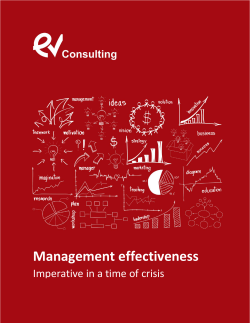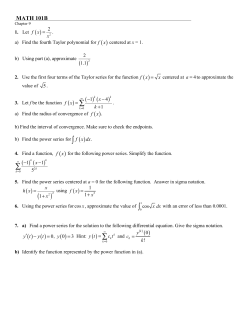
PERFORMANCE MEASURES - Chapter 11
PERFORMANCE MEASURES Chapter 11 "We want to change the competitive landscape by being not just better than our competitors, but by taking quality to a whole new level.” – Jack Welch Performance measures should aim at the longterm and should be forward-thinking initiative designed to fundamentally change the way corporations do business. It is not a postmortem of what happened but a step towards how we do better in the future. Why measure performance? Objectives for for-profit organizations: – Measure changes to stakeholders wealth; put in simple terms, the value of a firm. – Reward an employee for contributing to increase in firm value Issue: How would a firm measure an individual’s contribution to value creation and what purpose does it serve? The value concept (Results control) • The performance measurement concept indicates that employees can increase the value of the firm by – Increasing the size of a firm’s future cash flows, – By accelerating the receipt of those cash flows, or – By making them more certain or less risky. If you are a CEO or CFO, how would you increase the cash flows? Measure the right things • An ideal performance management system is one that energizes the people in an organization to focus effort on • Improving things that really matter – • One that gives people the information and freedom that they need to realize • Their potential within their own roles and that aligns their contribution with the success of the enterprise. Then, why do performance measures fail? • Root cause: complexity - details, details, details • Staff who collect data get frustrated. • Follow: What has to be done" (WHTBD). Measure What Matters • Easy to say but difficult to do. • Find out what is valued both by customers and stakeholders • Examples: process: new product • development, measure: time to market. • process: customer service, measure: customer retention. process: treasury management, measure: cost of service vs. value created. Keep it simple • Performance Measures must be • • simple to operate • simple to understand • • simple to action • Ex: If a sales person spends too much time on call reporting, they have less time for making calls. Let us now examine how real world firms measure performance and we will, later, find out whether these measures conform to the concepts we just discussed. Most organization measure performance using accounting measures – Net profits, gross margin, ROA, ROE, etc. Why do organizations choose accounting data as measures of performance? • Accounting profits and returns can be measured on a timely basis relatively precisely and objectively. • Because they are timely, precise, and objective, employees would react positively. • The short term measures keep employees on check. Why accounting measures of performance are not adequate? • Accounting measures are lagged indicators. • Dependent on the choice of measurement method. Accounting can create management myopia • Accounting is short term earnings or returns. • Why focusing on the short term is inappropriate? • Why would this short-term focus affect long-term relationships? The Changing Business Environment Are historical accounting measures adequate for today’s business environment that transcend global boundaries? Performance Measurements for the new era • In the global, technology-driven, decentralized environment, measuring • Financial performance, while important, is not adequate. • Even if less than precise, other measures of performance are required. • These measures should be capable of measuring multiple attributes of an organization. We need a balanced set of Performance Measures – We need both lead and lag indicators Lead indicators as value drivers • Many non-financial indicators can serve as lead indicators in certain settings. • Common examples are: – Market share, backlog (book-to-bill ratio), new product introductions, new product development lead times, product quality, customer satisfaction, employee morale, personnel development, inventory turnover, bad debt ratio, or safety Lag Indicators • In contrast to lead indicators, lag indicators are measures that point to earlier plans and their execution. • Financial performances are lag indicators. • Many times, financial performances are too late to affect future products and services. • Therefore, we need multiple measures that include both financial and non-financial measures. Comprehensive Performance Measures must address 1. Financial performance 2. Customer satisfaction 3. Internal business process developments and 4. Allow an organization to learn and grow. Financial Performance can be measured by •ROA ROE, EPS etc. These measure are essential to summarize the economic consequences of strategy. Customer-related measures • Managers must identify the customer and market segments in which the business desires to compete. • Develop measures to track the business unit’s ability to create satisfied and loyal customers. Customer-based measures Customer Satisfaction Customer Loyalty Customer Retention Product and Service Attributes Image and Reputation Internal Business Process Measures Identify the critical internal processes for which the organization must excel in implementing its strategy. • IBP dimension enable the business unit to – deliver the value propositions that will attract and retain customers in targeted market segments, and – satisfy shareholder expectations regarding financial returns. Internal Business Process Measures Innovation processes Operation Processes Quality Measures Cycle Time Measures Cost Measures Learning and Growth measures • • Learning and growth identifies the infrastructure an organization must build to create long-term growth and improvement. Growth comes from: people, systems and organizational procedures. A performance concept that combines everything that we discusses so far is Six Sigma The Six Sigma • Is “a business process that enables companies to increase profits dramatically by streamlining operations, improving quality, and eliminating defects or mistakes in everything a company does. “ • The objective is change the process so that defects are never produced in the first place. The objectives of Six Sigma • To ‘satisfy the customer’ by changing internal performance and processes. • To enable better performance by better design • To improve the ‘quality’ of supplies and other operational processes. • Manage the costs Six Sigma points out • You don't know what you don't know You can't do what you don't know • You don't know until you measure • You don't measure what you don't value • You don't value what you don't measure Difference between TQM and Six Sigma • TQM focuses on improvement in individual operations with unrelated processes; takes many years before all operations within a given process are improved. • Six Sigma focuses on making improvements in all operations within a process, producing results more rapidly and effectively.
© Copyright 2025





















